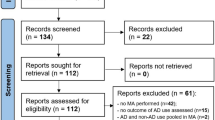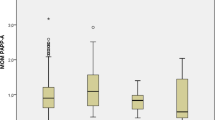Summary
Arachidonic acid (AA) and its metabolites are responsible for the regulation of the umbilical blood flow. We investigated the prostaglandin (PG) synthesis in umbilical arteries and veins of 16 smoking and 17 non-smoking mothers. AA and PGs were analyzed after extraction of samples by means of thin layer chromatography (TLC). Of all the AA metabolites in umbilical arteries and veins, prostacyclin reached the highest concentration. In non-smoking mothers the conversion rate of AA in arteries and veins was similar. The only exception was PGE2 which showed a significantly lower concentration in umbilical veins of smoking mothers. However, the influence of PGE2 on the blood flow of umbilical arteries and veins seems to be of minor importance compared to other vessels.
Similar content being viewed by others
References
Asmussen I, Kjeldsen K (1975) Intimal ultrastructure of human umbilical arteries. Observations on arteries from newborn children of smoking and non-smoking mothers. Circ Res 36:579–584
Dadak Ch, Leitner Ch, Sinzinger H, Silberbauer H (1981) Diminished prostacyclin formation in umbilical arteries of babies born to women who smoke. Lancet 1:94
Dadak Ch, Kefalides A, Sinzinger H, Weber G (1982) Reduced umbilical artery prostacyclin formation in complicated pregnancies. Am J Obstet Gynecol 144:792–795
Janisch H, Leodolter S (1973) Placental blood flow in risk pregnancies. Z Geburtshilfe Perinatol 177:74–80
Moncada S, Gryglewski RJ, Bunting S, Vane JR (1976) An enzyme isolated from arteries transforms prostaglandin endoperoxides to an unstable substance that inhibits platelet aggregation. Nature 263:663–665
Moncada S, Higgs EA, Vane JR (1977) Human arterial and venous tissues generate prostacyclin (prostaglandin X), a potent inhibitor of platelet aggregation. Lancet I:18–21
Myatt L, Elder MG (1977) Inhibition of platelet aggregation by a placental substance with prostacyclin-like activity. Nature 268:159–160
Noren H, Lindblom B, Wilhelmsson L (1982) PGE2 and PGF2α have more potent effects on nonpregnant human arteries than on umbilical arteries. 5th International Conference on Prostaglandins (Abstr.), University Press, Milano, p 429
Remuzzi G, Misiani R, Muratore D, Marchesi D, Livio M, Schieppati A, Mecca G, de Gaetano G, Donati MB (1979) Prostacyclin and human foetal circulation. Prostaglandins 18:341–348
Trudinger BJ, Giles WB, Cook CM, Bombardieri J, Collins L (1985a) Fetal umbilical artery flow velocity waveforms and placental resistance: clinical significance. Br J Obstet Gynaecol 92:23–30
Trudinger BJ, Giles WB, Cook CM (1985b) Uteroplacental blood flow velocity-time waveforms in normal and complicated pregnancy. Br J Obstet Gynaecol 92:39–45
Ulrich W, Dadak Ch, Sinzinger H (1984) Ultrastrukturelle Befunde an Nabelschnurarterien bei EPH-Gestose, juvenilem Diabetes mellitus und rauchenden Müttern. Vasa 13: 11–18
Author information
Authors and Affiliations
Rights and permissions
About this article
Cite this article
Dadak, C., Deutinger, J., Reinthaller, A. et al. Prostaglandin metabolism in umbilical vessels of smoking and non-smoking mothers. Arch. Gynecol. 240, 9–12 (1987). https://doi.org/10.1007/BF02134058
Issue Date:
DOI: https://doi.org/10.1007/BF02134058




